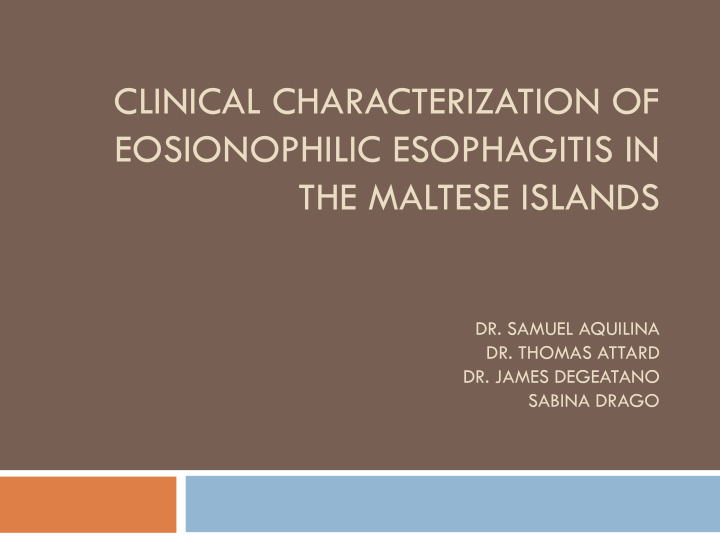



CLINICAL CHARACTERIZATION OF EOSIONOPHILIC ESOPHAGITIS IN THE MALTESE ISLANDS DR. SAMUEL AQUILINA DR. THOMAS ATTARD DR. JAMES DEGEATANO SABINA DRAGO
Eosinophilic Esophagitis • Relatively new diagnosis – 1975 first case (adult) – Description of 10 cases – Kelly 1995 – Increasing rates of diagnosis and studies Definition: • • Clinicopathological disease – Primary disorder of the esophagus; chronic – Esophageal and/or upper GI symptoms – Intraepithelial eosinophilia in mucosa – Absence of GERD; Lack of response to high dose PPI (2007) – ***2011 update: PPI-responsive esophageal eosinophilia
2011 update EE to EoE Inclusion of terms Chronic Immune/antigen driven Inclusion of new treatments Issue of GERD – can cause eosophageal eosinophilia PPI-responsive esophagela esoinophilia Some patients with EoE have less than 15 eosinophils/HPF
The Study Aim To characterize the paediatric EoE population Method Endoscopy database reviewed – 132 individuals Chart review of individuals meeting diagnostic criteria for EoE Inclusion criteria <18 years, endoscopy done Sept09 – October10, EoE appearance on endoscopy (furrowing, nodularity), eosinophilia (>15 per hpf) noted on esophageal biopsies Exclusion criteria Other concurrent illness (e.g. 1 patient with Crohn’s )
The Study - Results 4 individuals identified 3% of endoscopy population Male 3 vs female 1 Age range: 1 – 8 years; Mean age 3.75 years Presentation: Patient Symptoms 1 Vomiting Food refusal 2 Vomiting Food refusal 3 Vomiting Persistent throat clearance 4 Vomiting 2 had neuro-disability No history of atopy studies show concomitant asthma, atopic dermatitis, food allergy
Neurodisability? Our patients Patient Gender Symptoms Neurodisability 1 Male Food refusal Cerebral palsy 3 Male Throat clearance Developmental delay Assad et al 89 patients with EoE Described relationship to Developmental delay (12%) Seizures (6%) Cerebral palsy (4%) Autism (1%) Pentiuk et al described developmental delay in 10/15 children with EoE Population of an Interdisciplinary feeding clinic
Post-study.... Prospective follow up Treatment with Intensified acid suppression Strict exclusion diet Ingested fluticasone After 1.5 months 3/4 = marked improvement (2 had resolution of symptoms) 1/4 = poor compliance to diet, with persistence of symptoms All patients underwent repeat endoscopy
Endoscopy biopsies Patient Biopsy – 1 st endoscopy Biopsy - Repeat endoscopy 1 “marked infiltration of “multiple biopsies from oesophagus eosinophils....numbers far exceed 20 fail to reveal the presence of any per high power field” eosinophils ” 2 “ hyperplastic mucosa...presence of “upper oesophagus....no eosinophils large number of intraepithelial identified” eosinophils ” 3 “biopsies taken from proximal “practically all high power fields oesophagus, there are large numbers show more than 20 eosinophils ” of eosinophils, numbering greater than 40 per high power field” 4 “ eosinophils....count in excess of “unremarkable oesophageal 20/HPF” squamous mucosa”
Histology Patient 1 Pre-treatment Post-treatment
Histology Patient 2 Pre-treatment Post-treatment
Histology Patient 3 Pre-treatment Post-treatment
Histology Patient 4 Post-treatment Pre-treatment
Recently... New patient identified 13 year old girl Presented with dysphagia Sister of patient 3 Biopsy “ intramucosal eosinophils with ocunts in excess of 100/HPF” in lower oesophagus Genetic studies Candidate gene approach: Eotaxin-3 gene Genome-wide analysis: EoE susceptibility locus 5q22
Clinical Expression Associations Clinical expression Typically Caucasian, Male Vary widely GERD-like symptoms: Atopic conditions heartburn and Genetic diseases (e.g. 2 regurgitation cases Rubenstein-Taybi) ?Poor response to PPI Dysphagia (adolescents +) Autoimmune disease Food refusal/ intolerance Coeliac disease (infants) Subglottic stenosis Emesis Occupational exposure Abdominal pain Neurodisability Failure to thrive
Work-up Endoscopy Only reliable diagnostic test No pathognomonic feature 2 to 4 biopsies, proximal and distal Described: Longitudinal furrowing (epithelial oedema) White exudates Concentric rings Friability, crepe paper mucosa Biopsy At least 15 eosinophils in one high power field
Treatment Diet Restriction Elemental diet Pharmacology Steroids Fluticasone – inhaled, topical Montelukast Acid suppression with PPIs Biologics – still being studied
Future challenges Still a new diagnosis for our island Neurodisability and EoE Delay in diagnosis Overlap with GERD Earlier start of PPI trial, earlier endoscopy, ?earlier diagnosis
References Liacouras CA, Furuta GT, Hirano I, Atkins D, Attwood SE et al. Eosinophilic esophagitis: Updated consensus recommendations for children and adults. J Allergy Clin Immunol. 2011 Jul;128(1):3-20. Furuta GT, Liacouras CA, Collins MH, Gupta SK, Justinich C. Eosinophilic esophagitis in children and adults: a systematic review and consensus recommendations for diagnosis and treatment. Gastroenterology. 2007 Oct;133(4):1342-63. Brown-White-horn T, Liacouras CA. Eosinophilic esophagitis. Curr Opin Pediatr 19:575-580. Straumann A, Hruz P. What’s new in the diagnosis and therapy of eosinphilic esophagitis? Curr Opin Gastroenterol 25:366-371. Assad AH, Putnam PE, Collins MH et al. Pediatrics patients with eosinophilic esophagitis: an 8 year follow up. J Allergy Clin Immunol 2007; 119:731- 738 Pentiuk SP , Miller CK, Kaul A. Eosinophilic esophagitis in infants and toddlesrs. Dysphagia 2007; 22:1-5.
Thanks
Recommend
More recommend